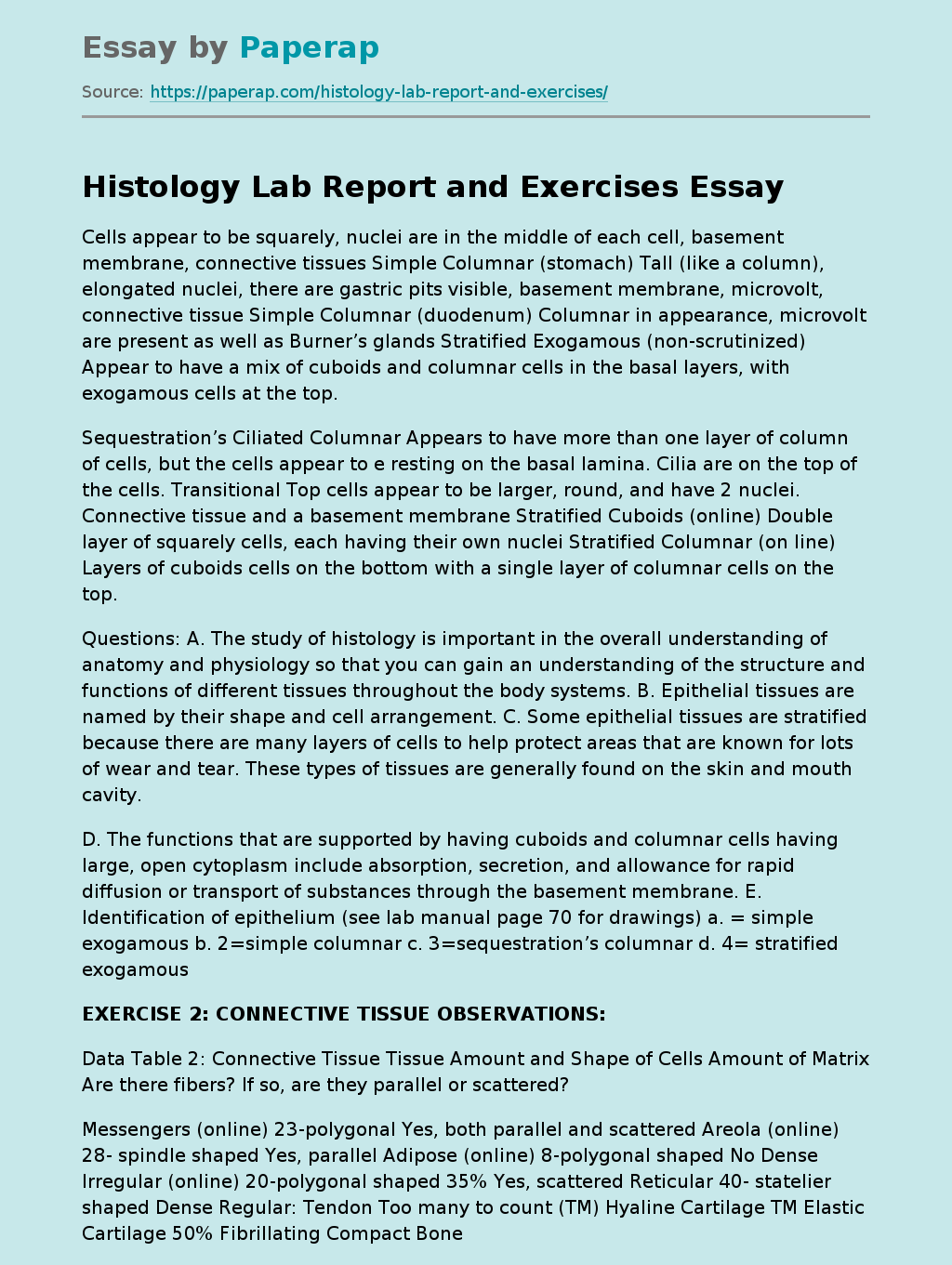Histology Lab Report and Exercises
Cells appear to be squarely, nuclei are in the middle of each cell, basement membrane, connective tissues Simple Columnar (stomach) Tall (like a column), elongated nuclei, there are gastric pits visible, basement membrane, microvolt, connective tissue Simple Columnar (duodenum) Columnar in appearance, microvolt are present as well as Burner’s glands Stratified Exogamous (non-scrutinized) Appear to have a mix of cuboids and columnar cells in the basal layers, with exogamous cells at the top.
Sequestration’s Ciliated Columnar Appears to have more than one layer of column of cells, but the cells appear to e resting on the basal lamina.
Cilia are on the top of the cells. Transitional Top cells appear to be larger, round, and have 2 nuclei. Connective tissue and a basement membrane Stratified Cuboids (online) Double layer of squarely cells, each having their own nuclei Stratified Columnar (on line) Layers of cuboids cells on the bottom with a single layer of columnar cells on the top.
Questions: A. The study of histology is important in the overall understanding of anatomy and physiology so that you can gain an understanding of the structure and functions of different tissues throughout the body systems. B. Epithelial tissues are named by their shape and cell arrangement. C. Some epithelial tissues are stratified because there are many layers of cells to help protect areas that are known for lots of wear and tear. These types of tissues are generally found on the skin and mouth cavity.
D. The functions that are supported by having cuboids and columnar cells having large, open cytoplasm include absorption, secretion, and allowance for rapid diffusion or transport of substances through the basement membrane.
E. Identification of epithelium (see lab manual page 70 for drawings) a. = simple exogamous b. 2=simple columnar c. 3=sequestration’s columnar d. 4= stratified exogamous
EXERCISE 2: CONNECTIVE TISSUE OBSERVATIONS:
Data Table 2: Connective Tissue Tissue Amount and Shape of Cells Amount of Matrix Are there fibers? If so, are they parallel or scattered?
Messengers (online) 23-polygonal Yes, both parallel and scattered Areola (online) 28- spindle shaped Yes, parallel Adipose (online) 8-polygonal shaped No Dense Irregular (online) 20-polygonal shaped 35% Yes, scattered Reticular 40- statelier shaped Dense Regular: Tendon Too many to count (TM) Hyaline Cartilage TM Elastic Cartilage 50% Fibrillating Compact Bone TM, round in shape Human Blood A. The primary function of connective tissue is to join bodily structures (bones, muscles, etc. ) together and to hold tissues (muscles, tendons, organs, etc. ) in place. B.
The shape of a cell gives us insight into the function of the tissue (fiat cells protect, large open cells store or secrete materials, etc. ) C. The matrix is non-cellular material, usually made of protein, that provides support for certain tissues and acts as a filter between the tissue cells and the blood. D. Collagen fibers provide support, flexibility, and strength for the connective tissue. E. The limited blood supply of tendons, ligaments, and cartilage could slow the healing process of the body due to fewer nutrients and oxygen that is being delivered via the blood.
EXERCISE 3: MUSCLE TISSUE
Data Table 3: Muscle Tissue Muscle Type Shape and Arrangement of Cells Striations Present? Fibrous, multifaceted yes Smooth Thin-elongated cells, large oval nuclei Cardiac Cross striations (not as obvious as skeletal), one nucleus present in the center of each cell yes QUESTIONS: A. Smooth muscle would be found in the stomach. B. Smooth muscle differs from skeletal muscle in the way that it does not have striations present and it’s an involuntary muscle. C. Skeletal muscle is considered voluntary because these muscles are used under our conscious control.
They are stimulated by impulses from the brain/spinal cord. D. Cardiac muscle is unique because it is an involuntary striated muscle that in sometimes mimics smooth muscle and at other times skeletal muscles. It has the ability to contract involuntarily, but also carries an action potential. However, the appearance of the cells resemble skeletal muscle.
EXERCISE 4: NERVOUS TISSUE
A. The function of the nervous tissue is to respond to stimuli and then send impulses to various organs in the body. B.
The cell bodies of the neurons are elongated into cell processes so that they can transfer a signal from the dendrites to cells in the body. C. Eyes can’t hear a sound and ears can’t see light because the body is “wired” in such a way that each nerve is designed to respond and transmit specific stimuli from specific areas of the body. D. The difference between a nerve and a neuron is that a neuron is the basic cell of the nervous yester and is comprised of the cell body, dendrites, and an axon and is a single cell that has the ability to become excited.
A nerve is a bundle of fibers that are made up of many neurons.
CONCLUSIONS:
The study of histology is an important part of anatomy and physiology. It allows for the understanding of the structure and function of cells, tissues, and the role that they play throughout our bodies. Without the knowledge of histology little else will make sense in regards to anatomy and physiology. Histology is the foundation of the function of the human body.
Histology Lab Report and Exercises. (2019, Dec 05). Retrieved from https://paperap.com/histology-lab-report-and-exercises/

